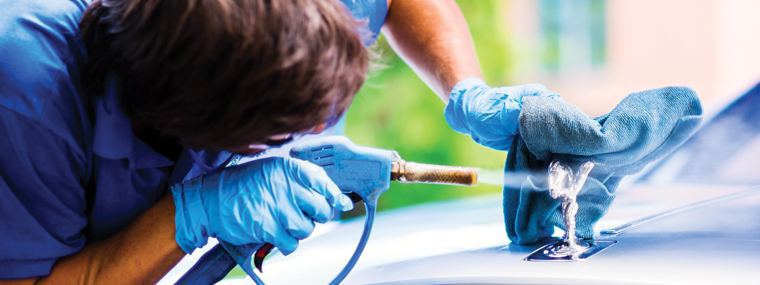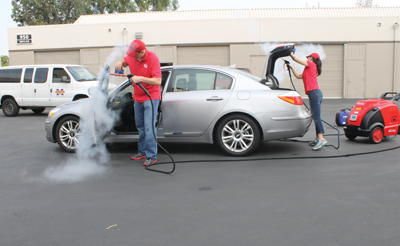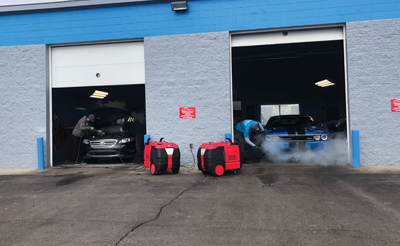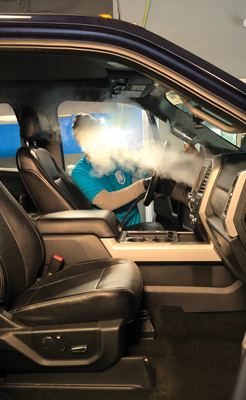
Recent Developments and Trends in the Car Wash Industry
By Diane M. Calabrese / Published May 2023

Every trend doesn’t begin with an innovation, but every innovation that becomes widely adopted begins a trend.
It’s no surprise that in an increasingly digital world, streamlining or simplifying spurs a great deal of change. The car wash industry is no exception.
What’s a recent development? “I think one big trend is to the subscription-based model,” says Jeff Theis, co-founder, president, and CEO of ProPulse—a Schieffer Company, based in in Peosta, IA. “For example, a company offers unlimited washes for a monthly fee.”
Theis explains there are plusses and minuses on each side of the seller and buyer equation. “For investors, this is often a creative way to generate reliable income. Customers seem to like it too.”
The equation must be kept in balance. “The downside—for investors—can arise if a particular market becomes saturated with too many washes, which may threaten the margins,” says Theis. “But consumers benefit from stronger competition.”
Given the investment owners make in their vehicles—for most, it’s second only to a house—they want to keep it clean (and in optimal working order). A subscription service for washes makes that easy to do.
Car wash facilities have benefited from the ever-increasing consumer interest in a stewardship of resources. They can demonstrate the judicious way in which they use, collect, and in more and more instances, treat and reuse water.
Car wash facilities have also benefited from the interval of societal disruption that began in spring 2020. With more emphasis on hygiene, car owners and particularly ride-share drivers wanted more frequent washes.
Even though many people began to work from home during the difficult interval, those who did go to an employer’s site abandoned mass transit. In most metropolitan areas, buses and light rail are still not anywhere near capacity for two reasons.
One, many people still do not trust the sanitary conditions on public transportation. Two, many people—federal and state workers—still do not go to an employer’s site five days each week; and when they do go, many former public transit riders now opt for a car.
As in all spheres of the economy, employee recruitment and employee retention have become difficult in this decade. The International Carwash Association® (Carwash.org), which is headquartered in Glen Ellyn, IL, offers LEAD™ training for car wash managers, an approach to help stabilize the sector’s workforce.
As members of our industry know, LEAD emerges from the premise that the more engaged and knowledgeable employees become, the more resourceful and skilled they are. They stay longer in a position because they know their contributions to the business are important and appreciated.
Heated Trajectory
Some trends already underway in the car wash industry got a boost from the recent heightened interest in sanitary environments. “During the pandemic, many retailers and commercial steamers started offering sanitization services for businesses and schools,” says Yujin Yoo Anderson, general manager at Steamericas in Gardena, CA.
Responding to growing customer interest in cleanliness might have caused some contractors to enter the steam cleaning niche. But once in the niche they stayed because of the return on investment it brings.
“Steam is an all-in-one tool that can replace air compressors, extractors, and brushes or agitation tools,” says Anderson. “Its natural pressure, which is typically 100 to 125 psi, is gentle yet strong enough for auto interior surfaces.”
In addition to the stronger embrace of steam by the car wash industry, Anderson sees other significant trends. Start with convenience, which once experienced is difficult to forfeit.
Owners who hired a mobile car wash service to come to their homes in 2020–2022 have stayed with the mobile wash because it’s so convenient, explains Anderson. “From a car wash operator’s standpoint, rising rents and other fixed costs make mobile operations more attractive as well.”
Thoroughness is another trend. While car owners wanted to conclude a wash with a clean car, they rarely thought about just how specific an interior cleaning had been. If it looked good—no visible debris on seats and carpets—it was fine.
Not so now after the experience with a fast-spreading virus. That experience “spotlighted the need for better cleaning than what meets the eye,” says Anderson. “The demand for interior cleaning has increased tremendously.”
Car washes of all types have expanded their services to meet the demand. Some use low prices to get customers to a facility and then offer interior cleaning or detailing to generate more revenue, explains Anderson.
Detailing itself is becoming “more mainstream,” says Anderson. And it can be quite profitable. [See separate articles about detailing on page 6 and steam cleaning on page 26 for more about each topic.]
A huge propellant of trends in the car wash industry has been with us for decades now. It’s the outgrowth of regulations from the Clean Water Act. With restrictions on water use and requirements for reclamation both growing, car owners seek out professional car wash establishments, explains Anderson.
“A significant portion of our company’s incoming leads share a common buying motive, which is to bypass wastewater restrictions,” says Anderson. Obviously, not all restrictions, but the less wastewater, the easier it is to comply.
“Steam requires about one to two gallons of water to clean an average vehicle,” which is only a fraction of what you need using water,” says Anderson. Not only does that reduce the wastewater stream, but it also speeds up the process.
“You spend less time filling up the water tank,” explains Anderson. Moreover, there’s a cost savings in fuel for the fleet, given so much less water needs to be carried to a job site.
Size, Scale, and Scrutiny
Most car washes are small businesses, but in the aggregate car wash sales totaled $9.7 billion in 2019, according to most recent data from the U.S. Census Bureau (Census.gov). That figure is certainly more now. (IBISWorld, an industry analyst group, projects $14.5 billion in sales—car wash and detailing combined—in 2023.)
Automatic washing (e.g., tunnel washes) generates more than half the revenue in the sector. Self-serve washing and vacuuming installations account for about five percent of revenue.
The number of car wash facilities tracks closely to state population. California, Texas, and Florida rank first, second, and third, respectively. Individual ownership is the norm.
Stronger enforcement by the Department of Labor is a trend in the car wash industry. (Add it to the givens of EPA and OSHA rules.) Car washes with annual sales or business revenue at $500,000 or more and two or more employees are subject to the provisions of the Fair Labor Standards Act (FLSA).
The FLSA adds to the requirements for business owners. And it may surprise some facility owners to learn that it applies to their enterprise. Surprised, because they do not meet the revenue threshold or have two employees.
A business is subject to FLSA regulations if it engages in interstate commerce. Interstate commerce is defined broadly, so that communications with individuals in another state and credit card transactions tied to interstate banking are among the criteria that count.
It’s all about increased scrutiny of businesses, a commitment of the current administration as it endeavors to ensure all employees receive fair compensation. Car washes covered by the FLSA must pay at least federal minimum wage and overtime for every hour more than 40 worked during a week. The overtime pay must be at least time and one-half of the regular hourly rate.
Increased scrutiny is a major trend being experienced by all small businesses. Car washes are no exception.
FLSA also encompasses recordkeeping and rest and meal periods, and it assesses whether employees are categorized appropriately. It aims to ferret out and stop the classification of certain employees as independent contractors and get them reclassified as employees. (California is ahead of the federal government in this effort.)
Automation in the car wash industry is certain to grow with the sophistication of robots. The more range of motion a robot has, the more autonomy and the more possibilities for supplanting humans.
For example, employees are required (mostly as monitors) at both automated car washes in which a car remains stationary and the cleaning arms move around it and at tunnel washes in which a car moves along a conveyor through soap, wash, rinse and dry cycles. If on-site monitoring could be handled by a robot, it would be possible to run a car wash facility remotely by receiving visual feeds and alerts to problems.
 More help from robotic design could free employees to take on other responsibilities. Washing could be monitored remotely by an employee engaged in detailing a vehicle. Combining service offerings is a trend across industries (think pharmacies, bakeries, and coffee bars inside grocery stores). And it’s a trend that can strengthen and sustain car wash facilities.
More help from robotic design could free employees to take on other responsibilities. Washing could be monitored remotely by an employee engaged in detailing a vehicle. Combining service offerings is a trend across industries (think pharmacies, bakeries, and coffee bars inside grocery stores). And it’s a trend that can strengthen and sustain car wash facilities.
A vehicle owner cannot purchase the service of cleaning or detailing from outside the United States. That means investment in car wash facilities is far less precarious than investment in businesses with intense global competition.
The sum of the foregoing is the biggest trend: a sector with healthy growth potential.











